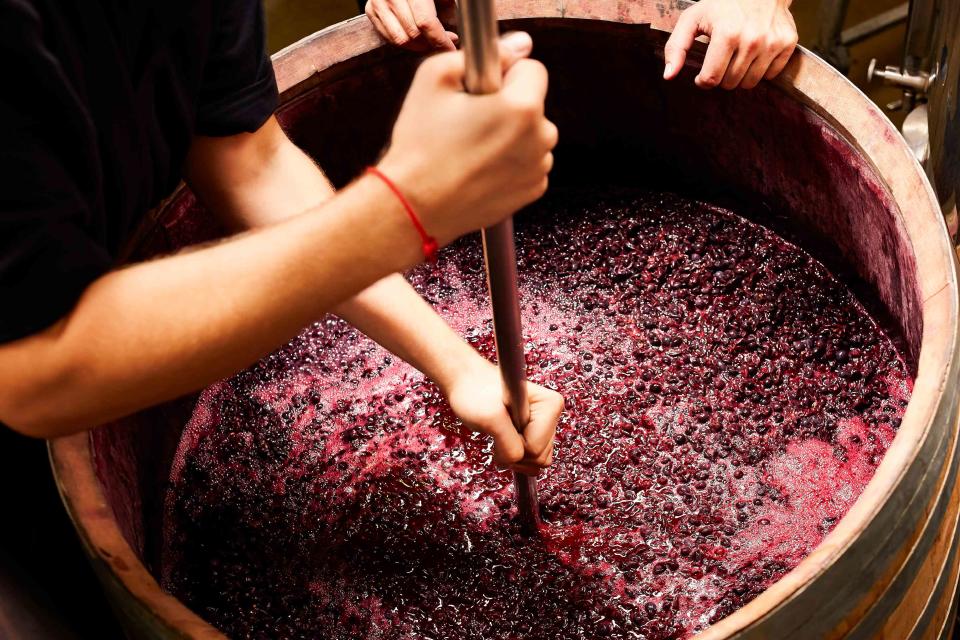You'll Be Surprised by How Many Grapes it Takes to Make One Bottle of Wine
Winemaking isn't just about how many grapes are used, but how those grapes are handled and processed.

Morsa Images / Getty Images
You likely already know that wine is produced from fermented grape juice, but just how many berries does it take to get your standard-size bottle of vino? Turns out, a lot of variables play into the answer to that question — and the final number of grapes is probably more than you may think!
Across the board, professionals agree that it takes an average of 1.25 to 1.50 kilograms (2.75 to 3.3 pounds) of grapes to make a standard-size bottle of still wine. “So many factors affect the [final number], though cluster and berry size are the most crucial factors,” says Paul Sloan, winemaker at Small Vines. The final number can clock in anywhere from 600 to 800 grapes, though go all the way up to multiple thousand grape berries, depending on the grape variety and wine style at hand.
Nicholas Gizuk, winemaker at Inniskillin, notes that wine style and harvest conditions also greatly affect the number of grapes used to produce a standard-size bottle of wine. Additionally, decisions in the cellar also play a role in the final number of grapes used. “In still winemaking, we can use multiple techniques in the winery to manipulate the pressing of grapes,” Gizuk explains, citing that juice is most often fractioned off from free run juice versus pressed juice. Sloan elaborates on this, stating that using or not using pressed wine will also play into the number of grapes used — as well as the quality and concentration — of the finished wine. [Press wine will require one to use less grapes, as more juice will come out of each berry.]
In the case of dessert wine, however, a significantly larger number of grapes is required. Zoltán Kovács, winery director of Royal Tokaji, shares that to achieve the same volume of Aszú wine as a dry wine, the winery needs approximately 2.71 times more healthy grapes, and for the estate’s top-tier Essencia, a staggering 262.4 times more berries. Elaborating on this, Kovács shares that the specific style of dessert wine affects the tonnage of grapes used.
“For the sweet Aszú wines, we need concentration by botrytizing and shriveling, so a lot of weight is lost during this type of grape maturation.” he says, stating this as the main reason why the winery requires significantly more grapes to make the same amount of sweet wine. “For our Essencia, which is the purest expression of a Tokaj Aszú wine (0.375mL/bottle), it requires 49,680 botrytized berries, which is about 32.8kg,” he says. “Expressed in healthy grapes, it would be a staggering 164kg of grapes.”
Dustin Valette, chef-owner at The Matheson, Valette, and Valette Wines, explains that grapes for dessert wine are picked with a much lower water content — up to 75% less — and therefore, would be four times less weight than a standard wine grape variety. Gizuk shares that in ice wine production, at one tonne (1000kg) of Riesling, Gewurztraminer, or Cabernet Franc grapes will generally give 100 to 125 liters of juice — which, when frozen, processed, and fermented, will give 90 to 112 liters of finished wine. “This means that these varieties require 3.5 to 4.5kg of grapes to produce one 375ml bottle,” he says. [Note: This is deemed a half-size bottle for standard still wines.]
Gizuk sums it up best. “It almost always comes down to location, growing conditions, variety style/challenges, and the ability to get the best possible grapes to the winery to make the desired product,” he says.
For more Food & Wine news, make sure to sign up for our newsletter!
Read the original article on Food & Wine.

